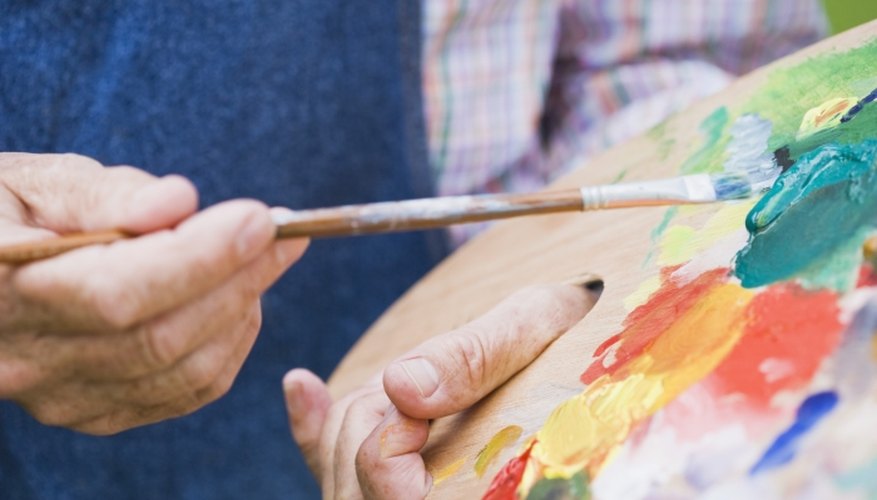Olive green is a neutral green colour that look like the colour of a green olive. Some commercial paint companies, such as Winsor & Newton and Gamblin, produce an olive green in tube paint, but it is generally difficult to find in art-supply stores. Besides the colour of olive tube paint, many different shades of olive green can be made by mixing other pigments that most artists already have in their paint sets.
Making olive from sap green
Adding many different pigments to sap green can produce varying shades of olive green. Sap green is a green that falls in the middle of the green section of the colour wheel and is a very natural or earthy-green tone, often being used for leaves on trees or grass on the ground. Adding a blue-violet pigment such as ultramarine violet or dioxazine purple will create a cool dark olive green. Mixing sap green with cadmium orange, cadmium yellow or a bight yellow such as lemon yellow or Naples yellow will create a warm, but dark, olive green that is similar to Winsor & Newton's olive green.
- Adding many different pigments to sap green can produce varying shades of olive green.
- Adding a blue-violet pigment such as ultramarine violet or dioxazine purple will create a cool dark olive green.
Using neutral earth tones
Using the earth tones yellow ochre, raw sienna, raw umber and burnt umber with blues and blue greens can create an olive-toned paint colour. The earth tones are close to olive green, or the isoindolinone yellow pigment, in their neutrality, but are redder and warmer than the cool olive green. Mixing ultramarine or cobalt blue with yellow ochre will make an olive green, but a Prussian or phthalo blue will make a dark, vibrant olive green. Combining phthalo blue to burnt sienna, raw umber and burnt umber will make a dark, cool olive colour. Notice, however, that mixing the dark earth tones raw umber and burnt umber to the blue pigments ultramarine, Prussian and cobalt will result in a colour that is closer to black than olive.
- Using the earth tones yellow ochre, raw sienna, raw umber and burnt umber with blues and blue greens can create an olive-toned paint colour.
- Notice, however, that mixing the dark earth tones raw umber and burnt umber to the blue pigments ultramarine, Prussian and cobalt will result in a colour that is closer to black than olive.
Complementary
Mixing complementary colours, colours that are directly opposite from each other on the colour wheel, is a way that artists create neutral colours. When complements such as red and green are combined, they create a neutral or grey colour. Red pigments like alizarin crimson and quinacridone, two deep, semi-purple reds, or magenta can be added to sap green, hooker's green or permanent green light to make a shade of olive green.
Adding colour to black
Adding any yellow pigment to a black pigment will typically result in an olive green. This green will appear very dark and dull, unlike the pigment mixtures described above, which will seem livelier by comparison.
